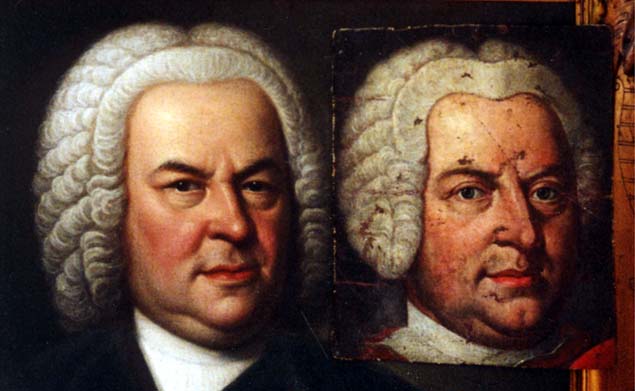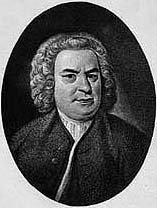The Critical Discographies from Choral Music On Records - Saint Matthew Passion Pages at the Teri Noel Towe
Home Pages
Johann Sebastian Bach
The Critical Discographies from Choral Music On Records
This remarkable photograph is not a computer generated composite; the original of the Weydenhammer
Portrait Fragment, all that remains of the portrait of Johann Sebastian Bach that belonged to his pupil Johann
Christian Kittel, is resting gently on the surface of the original of the 1748 Elias Gottlob Haussmann Portrait of
Johann Sebastian Bach.

1748 Elias Gottlob Haussmann Portrait, Courtesy of William H. Scheide, Princeton, New Jersey
Weydenhammer Portrait Fragment, ca. 1733, Artist Unknown, Courtesy of the Weydenhammer Descendants
Photograph by Teri Noel Towe
©Teri Noel Towe, 2001, All Rights Reserved
The Critical Discographies from Choral Music On Records
Saint Matthew Passion, BWV 244
Saint Matthew Passion, BWV 244
Bach's Own Performance Practice
The Saint Matthew Passion is the next to the last of the five Passions that Bach's sons recalled that their father
had written, and it is the second of the three of which we have definite knowledge. The first of the two is the
Saint John Passion, BWV 245, which is discussed elsewhere in this volume, and the third is the Saint Mark
Passion, written in 1731, for which only the text has been preserved. Very early on in the 19th century Bach
Revival, however, scholars realized that the Saint Mark Passion contained many reworkings of music used
elsewhere, and several conjectural recoveries of lost choruses and arias have been made. There is even a
recording of a completely reconstructed setting!
The Saint Matthew Passion, on the other hand, contains little that is borrowed and almost certainly nothing
that has been reworked from pre-existing music. In fact, as Joshua Rifkin has cogently argued, the SMP may
have been composed for "essentially private reasons" and also was "the first vocal contribution to that
remarkable, and evidently self-motivated, series of 'exemplary' works so strikingly characteristic of his output;
and it stands, too, as the piece that marked his inward resignation from his job as Thomaskantor." [1]
The first version of the Saint Matthew Passion was premièred in the Thomaskirche, Leipzig, on April 11,
1727. Originally, there was but one continuo line that accompanied the two four voice choirs rather than two
independent ones, and the obligatto instrument in the aria "Komm süsses Kreuz" and the preceding arioso
[Nos. 65 and 66] was a lute rather than a viola da gamba. The First Part lacked the chorale "Ich will hier bei
dir sterben" [No. 23], and, more importantly, ended not with the remarkable and monumental chorale fantasia
"O Mensch, bewein' dein Sünde gross", which Bach originally composed to open the 1725 version of the
Saint John Passion, but with a simple four-voice chorale setting. This first version, which has survived only in
a copy made by Bach's son-in-law Johann Christoph Altnickol in the mid 1740s, has never been recorded.
Almost two years later, early in 1729, Bach used the work as a quarry for nine arias as well as final chorus of
the funeral cantata he performed at the interment service for his one-time employer and friend, Prince Leopold
of Anhalt-Cöthen. In 1736, Bach came back to the SMP and prepared a beautiful "fair copy" of the revised
version that is familiar to audiences today and presented it, in the Thomaskirche, on Good Friday of that year.
The original performing materials for this "definitive" 1736 version have been preserved, and, as Joshua Rifkin
has convincingly demonstrated, an open-minded examination of those parts and their implications yields some
startling results. There are twelve vocal parts in all, one for each of twelve singers; no part was shared by more
than one performer. There are eight "basic" parts, containing both the "choral" and "solo" music for the
soprano, alto, tenor, and bass of each of the two "choruses". The remaining four parts are not doubling parts.
They contain only "extra" music not assigned to the members of the two "choral" quartets. There is a part for
the lone soprano who intones the chorale cantus firmus in the opening and concluding choruses of the First
Part; there is another soprano part that contains only the music for the First Maid, the Second Maid, and
Pilate's Wife. Lastly, there are two bass parts; one contains the music for Judas and the First Priest, and the
other contains the music for Peter, The High Priest, the Second Priest, and Pilate. None of these "subsidiary"
parts contains any of the music for any of the choruses or chorales. Furthermore, the parts for the Tenor and
the Bass of Chorus One are marked "Evangelist" and "Jesus" respectively, but they are devoid of any "cues"
for any doubling singers in the "choral" numbers. The conclusion is as inescapable as it is obvious. Bach
performed the SMP with a total of eight singers in the double choruses!
The instrumental complement was similarly intimate: a solo violin in each of the two bands, one of which
accompanies Chorus One and the other of which accompanies Chorus Two, two ripieno first violins, two
second violins, one viola, one cello, a violone, and - in 1736, at least - two continuo organs. None of the winds
was doubled.
That Bach could successfully have brought off a work as lengthy, as demanding, and as monumental as the
SMP with such intimate forces seems impossible to us nowadays, particularly since we know how
vociferously he complained about the inadequacies of the performing forces available to him. But the SMP is
remarkably carefully balanced work. The allocation of ariosos and arias between the members of the two
choruses assures that each concertist, as he was called, got ample time to rest; furthermore, the two Parts were
separated by the preaching of the Good Friday sermon, an especially long winded affair lasting some two
hours or so. The performers, therefore, had an adequate chance to recover their stamina before they had to
come back to sing and play the Second Part.
The two instrumental and vocal choruses were split between the two organ lofts, nearly 100 feet apart, but the
then favorable acoustics of the Thomaskirche made it possible to keep the two ensembles together. By the
time Bach revived the work in the early 1740s, however, the organ had been removed from the second loft,
and Bach was forced to substitute a harpsichord for the continuo of Chorus Two. It is something of an irony,
then, that, when harpsichord and organ are used together in "modern" performances of the SMP, the
harpsichord almost always accompanies the Evangelist, who is a member of Chorus One. To compensate for
the disappearance of this second organ, Bach added a second ripieno soprano to the opening and concluding
choruses of Part One. In all other respects, the vocal parts that Bach used in the early 1740s (almost certainly
1741) are the same ones that he used in 1736, and there is no evidence to support the contention that Bach
used additional singers for the "choral" numbers in this, most likely the last, performance of the SMP that he
presented.
The other significant change that Bach made in the score of the Saint Matthew Passion for the 1741 revival is
the addition of the chordal part for the viola da gamba in the arioso "Mein Jesus schweigt" [No. 40]; the viola
da gamba also plays the obligatto in the following aria "Geduld, Geduld". This alternate version is
occasionally, though infrequently, used; unless otherwise specifically mentioned, the reader may assume that
the 1736 versions of these numbers have been followed in the recordings discussed in this essay.
Needless to say, there has so far not been a commercial recording of the SMP reflecting Rifkin's "radical" but
as yet unrefuted analysis of the evidence, but those of us who had the good fortune to be in the audience at the
University of North Carolina in 1985, for the concert performance of the 1736 version given by Joshua Rifkin,
The Bach Ensemble, and a first rate cast of the best early music singers in America, including Ann Monoyios
and William Sharp among others, vividly recall that it was though we were hearing this familiar and beloved
masterpiece for the first time. The searing clarity, the poignancy, the emotional intensity, and the relentless,
heart rending drama of both score and text were conveyed with a power and sincerity surpassed by no other
approach to this music and equalled by few. It is fortuitous for all who are interested in how Bach heard his
music performed that this incredible performance was recorded for later broadcast on North Carolina Public
Radio and therefore quietly circulates privately among the cognoscenti. [2]
Of all the recorded performances of the SMP, whether with period instruments or modern ones, whether
"authentic" or "Romantic", there are but two in which the distinction that Bach draws between the singers of
Chorus One and the singers of Chorus Two is followed at all consistently through the "solos" and the
"choruses". Both of those recordings are conducted by Nikolaus Harnoncourt.
In the earlier of the two Harnoncourt sets [3], the first period instrument Saint Matthew Passion, the division
of the solos between members of the two Choruses is adhered to almost exactly; apart from a substitute Alto
soloist in two numbers, the only deviations are Harnoncourt's allocation of the part of Jesus and bass arias of
Chorus One to separate singers and his apparent assignment of the subsidiary rôles to the eight "soloists".
A modern double chorus, some 40 strong, is used, of course, but it is made up of boys' and men's voices.
The soprano solos are sung by two exemplary but anonymous soloists from the Wiener Sängerknaben, but
their birdlike voices, clear and pure though they are, are simply not mature enough, emotionally or physically,
for this music. Voices broke much later in Bach's day than they do now, and consequently the sound he and
his contemporaries heard was fuller than any one might expect to hear from a prepubescent voice today. The
use of a woman's voice of an appropriately boyish character is an inevitable compromise that must be made
nowadays by those who seek to perform this music in an "authentic" manner.
The adult soloists are all excellent. Particularly noteworthy are Paul Esswood and James Bowman, who bring
emotional commitment, technical security, and distinctive timbre to the alto music. Kurt Equiluz is one of the
great interpreters of the Evangelist's rôle. He sings the narration in a dramatic, but straight-forward and
conversational way; he "reads" the part, if you will, in the manner of a great actor. Karl Ridderbusch is an
excellent Jesus; he has a dark but natural voice, and his interpretation is suffused by a unique sense of
vulnerability and resignation as to inevitability of Christ's crucifixion.
The overall tactus is brisk. There is some stressing of strong beats, but this quirk of Harnoncourt's, which later
developed into a most disquieting mannerism, is not pronounced, and here serves only to heighten the
dance-like qualities that pervade so much of the music in the SMP. Although Harnoncourt was responsible for
shaping the overall interpretation, David Willcocks, then the Director of the Choir of King's College,
Cambridge, evidently conducted the choruses and chorales. As one might expect from a virtuoso gambist like
Harnoncourt, the 1741 forms of "Mein Jesus schweigt" and "Geduld, Geduld" are used.
The bloom and freshness of this extraordinary recording, which startled and opened the eyes and ears of many
of us when it first appeared in 1970, has not faded. It is still unsurpassed among the period instrument
recordings of the SMP, and it is has only a handful of equals overall.
Harnoncourt's second SMP [4] was recorded in concert at the Concertgebouw on March 31, 1985, at the
tenth annual performance he had given with the Concertgebouw; all of the artists waived their royalties for this
set, which is being sold to benefit the fund to restore the Concertgebouw, Amsterdam's magnificent and
venerable concert hall. For a variety of reasons, the interpretation unfortunately is nowhere near as successful
as Harnoncourt's first. For one thing, he uses a modern orchestra and chorus whom he has carefully schooled
in the replication of period timbres; they sound "modern" nonetheless. The natural but curious clarity and the
innate but bizarre incisiveness of period instruments just cannot be duplicated by modern ones.
Matters are not helped by a complement of soloists who are accustomed to singing the "modern" way.
Harnoncourt, however, once again comes close to replicating Bach's allocation of the "solos" among eight
singers, but this time, Kurt Equiluz sings only the Evangelist's rôle, again with distinctive character, pure sound,
and emotional clout. The tenor arias are overinterpreted by a rather wobbly Neil Rosenshein. Once again, all
the subsidiary rôles for which Bach provided parts for three additional singers are divided among the eight
soloists. The part of Jesus is not sung by the Bass in Chorus One, the rather dry and woolly Ruud van der
Meer who also sings Peter, Pilate, the High Priest, in addition to Judas, and, apparently, the First Priest. Anton
Scharinger, who evidently sings only the Second Priest in addition to the Arias assigned to the Bass in Chorus
Two, has a cleaner and more pleasing tone. Robert Holl is a fuzzy and posturing Jesus. The female soloists are
fine in the main. The mixed chorus is medium sized, and is augmented in the opening and closing choruses of
Part One by a boys' choir which sings the chorale cantus firmuses.
Surprisingly, there so far have only been two other period instrument recordings of the SMP released since
Harnoncourt's appeared two decades ago. (A fourth, under the direction of Ton Koopman, is scheduled for
release in 1990.) Philippe Herreweghe's interpretation [5] is less extroverted, less brilliant than Harnoncourt's,
and it does not emphasize the dance-like character of many of the movements to anywhere near the same
degree; instead Herreweghe's SMP is more reverent, more relaxed, and, paradoxically, more relentless in
character. It is imbued with a pervasive sense of gentleness, awe, and faith that sets it apart from all the other
recordings. The two ensembles that make up Choruses One and Two are both mixed choirs; the soprano
soloist is a woman; the alto a man. (Whether Bach used boys or men for his altos has been the subject of
some dispute; surely some of the more mature students at the Thomasschule were altos, and his son Carl
Philipp Emanuel was apparently a gifted falsettist.) The 1741 versions of "Mein Jesus schweigt" and "Geduld,
Geduld" are used.
René Jacobs's distinctive, plangent voice is perfectly suited to the alto solos; his exquisite account of
"Erbarme Dich, mein Gott" is among the most poignant on records. Like Ulrik Cold, the clear voiced, straight
forward Jesus, Howard Crook treats the Evangelist's rôle in a more conversational manner than most, and his
quiet and natural unfolding of the narrative comports perfectly with Herreweghe's contemplative view of the
score. In sum, this account of the SMP is every bit as satisfying Harnoncourt's first one, but in a different way;
the two sets complement each other neatly.
John Eliot Gardiner's recording, which appeared in November, 1989, is the most recent period instrument
account of the SMP. [6] Although there are eight soloists, the division of responsibilities among them does not
always follow Bach's allocation of the solos between Chorus One and Chorus Two; the assignment of the
ariosos and arias among the various singers apparently was based primarily on vocal range and timbre.
Anthony Rolfe Johnson is disappointing as the Evangelist; his voice is tattered and tender at the top, often
painfully so, and his interpretation is quite mannered. Especially annoying is the sudden halving of the tactus of
the narrative during the Crucifixion recitatives. Andreas Schmidt is fine, straightforward Jesus. Of the
remaining soloists, all of whom are first rate, the sensitive and clear-voiced Ann Monoyios is particularly
noteworthy. The relatively large mixed choirs and the mixed voice children's chorus that intones the cantus
firmus in the opening and concluding choruses of Part One all sing with assuredness and sensitivity.
Gardiner's approach to the Saint Matthew Passion is a traditional, classical one. It is tempting to describe his
interpretation as "Mozartian" in feeling, but it is perhaps most accurate to say that Gardiner's interpretation is
early nineteenth century in character. This fine reading evinces many of the characteristics of the conservative,
fleet, and direct approach taken by Felix Mendelssohn-Bartholdy and his followers.
Please click here to advance to Page 2 - The Mendelssohn-Bartholdy Tradition.
Endnotes
Alphabetical Discography
Please click here to return to the Critical Discographies from Choral Music On Records Main Page.
P. S.: Please don't forget that, if you are interested in a thorough, accurate discography of the recordings of
the Saint Matthew Passion that have appeared since the preparation of this article, you should go at once to
Aryeh Oron's remarkable Bach Cantatas Website.
Please click on  to return to the Johann Sebastian Bach Index Page.
to return to the Johann Sebastian Bach Index Page.
Please click on the  to return to the Teri Noel Towe Welcome Page.
to return to the Teri Noel Towe Welcome Page.
teritowe@alumni.Princeton.EDU
Copyright, Teri Noel Towe, 1989, 1997, 2001
All Rights Reserved
The The Critical Discographies from Choral Music On Records - Saint Matthew Passion Pages
at the Teri Noel Towe Home Pages are PPP Free web pages.

The The Critical Discographies from Choral Music On Records - Saint Matthew Passion Pages
at the Teri Noel Towe Home Pages have received the HIP Woolly Mammoth Stamp of Approval from The
HIP-ocrisy Home Page.